Published Aug 23, 2023
The Starfleet Insignia Explained
No Star Trek symbol captures the eye or imagination quite like the delta.

StarTrek.com
"The Starfleet Symbol." "The Arrowhead." "The Delta."
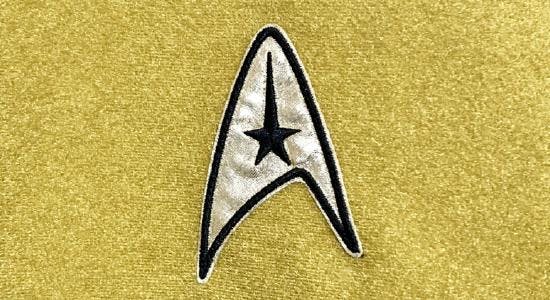
Star Trek uses symbols to convey a lot of things, but none captures the eye or imagination quite like the delta. In the years since The Original Series first aired, fans have tried to determine the meaning behind the various insignia shapes we see in the show. To most, it seems that the iconic delta shape is some sort of ship assignment patch meant to represent the U.S.S. Enterprise.
Some arrive at this conclusion because they see various Starfleet personnel wearing a number of different insignia. However, like any puzzle without a key, it’s impossible to precisely interpret the meaning of these other insignia.
The hidden key to the puzzle was finally uncovered a few years ago. The discovery was a memorandum written by producer Robert H. (Bob) Justman to costume designer William Ware (Bill) Theiss. The subject? STARSHIP EMBLEMS.
A copy of that memorandum has been digitized from the Gene Roddenberry Star Trek Television Series Collection (held in the Library Special Collections division of the Young Research Library at UCLA in Irvine, California) and is shown below:
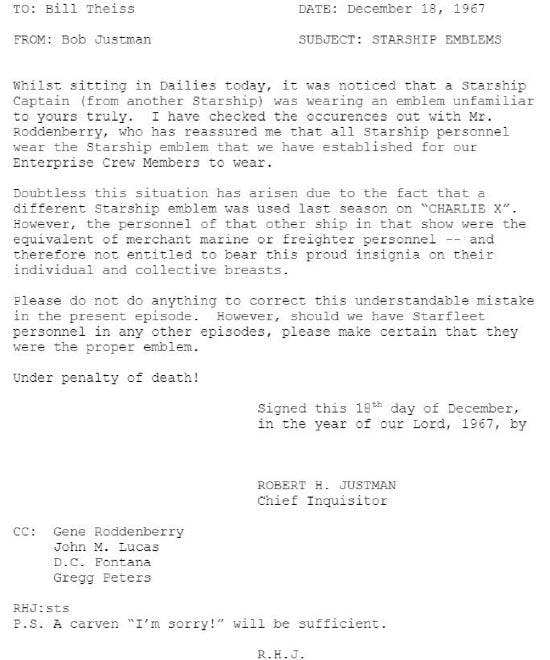
This memo, written during the production of the episode "The Omega Glory," and referencing Captain Ron Tracey, nullifies the long-held assumption that Starfleet assigned different insignia shapes to starships during TOS. Theiss’ inclusion of an alternate insignia for the Exeter's captain and chief medical officer, unfortunately, downplays how genuinely ubiquitous the delta insignia is within the Star Trek universe. As a result, fans of the series are left with conflicting visual information regarding the meaning of the insignia worn throughout the original series.
Nearly 50 years after Bob Justman wrote his memo, we now have the opportunity to clarify the use of each and every Starfleet uniform insignia used in TOS. With a wee bit of Scotty's ingenuity, and a pinch of Vulcan logic, the complete picture of what Gene Roddenberry envisioned for the delta insignia should snap into focus.
There are six Starfleet duty insignia used in The Original Series:
- Starship Duty Insignia (Fleet personnel emblem)
- Spacecraft Duty Insignia (Auxiliary Fleet/ Merchant Marine personnel emblem)
- Outpost Duty Insignia (Outpost and Colony personnel emblem)
- Cadet Duty Insignia (Starfleet Academy student emblem)
- Starbase Duty Insignia (Headquarters, Space stations, Drydocks, and Ground installation personnel emblem)
- Fleet Command Insignia (Senior field commander personnel emblem)
In the Star Trek universe, the delta emblem is a direct descendant of the vector component of the old NASA (and later UESPA) logos in use during Earth’s space programs of the 20th and 21st Centuries. Those symbols were worn by some of the first space explorers and adorned uniforms and ships during humanity’s first steps into the final frontier.
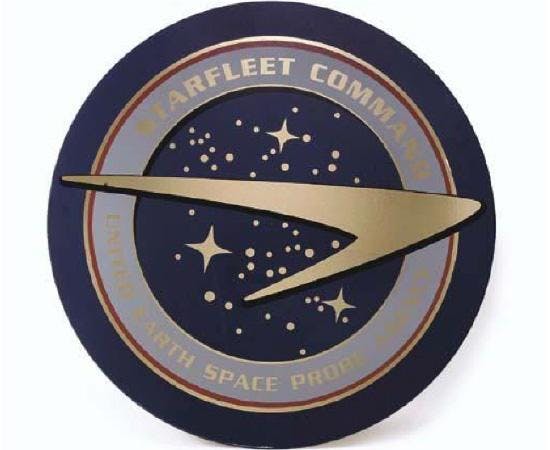
United Earth Space Probe Agency integrated with Starfleet as the leading United Earth space exploration service.
The delta insignia was first drawn in 1964 by costume designer William Ware Theiss with input from series creator Gene Roddenberry. The delta — or “Arrowhead” as Bill Theiss called it — has evolved into a revered symbol and one that's synonymous with Star Trek today.
The delta also conveys information about the wearer’s duties aboard ship using a series of division symbols. When paired with a distinctive, elongated “star,” the insignia represents someone assigned to the Command division aboard ship. When it displays the “planet” symbol, it represents the Sciences division, a stylized “e” stands for Engineering (later Operations), and a red “Swiss Cross” is worn by starship personnel assigned to the Nursing Corps.
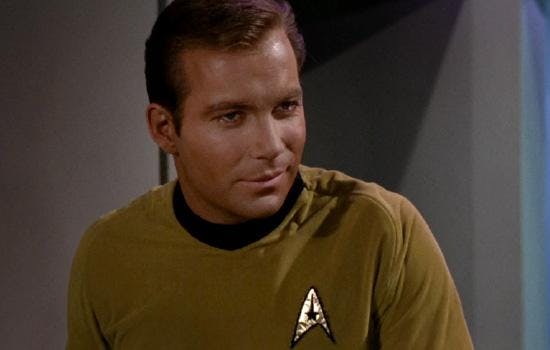
Captain James T. Kirk wearing the Starship Duty Insignia, Command Division.
Let’s continue our study of Star Trek’s insignia with personnel assigned to other starships that are wearing the delta insignia.
Before we knew about this memo, we assumed that each ship had its own unique insignia, but there are problems that theory doesn't account for. For instance, does it bother you, or at least seem odd to see the surly guys in Starbase 11’s Officer's Club (in the episode "Court Martial") giving “their captain” a hard time over the presumed death of their mutual friend Ben Finney? Or, to see deceased crew members aboard the U.S.S. Defiant (in the episode "The Tholian Web") wearing the delta insignia?
If different starships had different symbols, why weren't they wearing them? Simple. The memo makes it clear that those Starfleet officers are not assigned to the Enterprise; they are simply wearing Starfleet’s standard-issue Starship Duty Insignia.
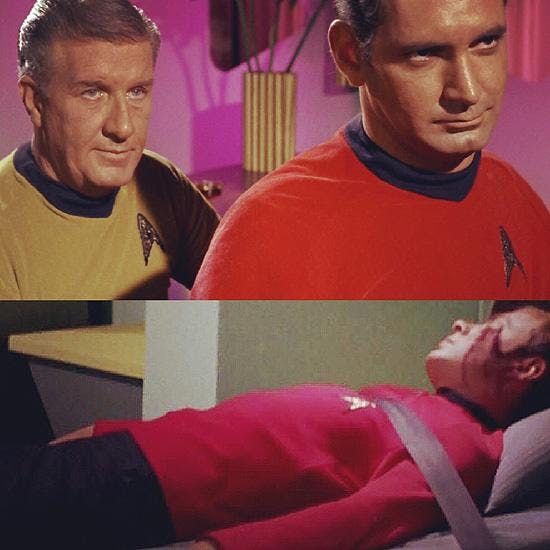
Non-Enterprise Starfleet personnel in Starbase 11’s Officer’s Club in Court Martial, and Below: Deceased U.S.S. Defiant crew member wearing the Starship Duty Insignia in "The Tholian Web."
By now, you might be saying, “What aboutU.S.S. Exeter’s Captain Ron Tracey and his chief surgeon, Dr. Carter?” As these two insignia patches are the error being addressed in the memo, they need no further explanation. They alone are the anomaly (an anomaly Theiss never repeated), which led to the misconception that every ship has its own assignment insignia.
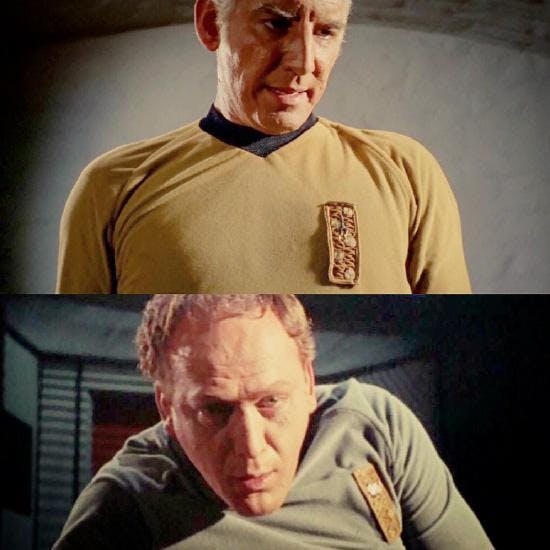
Above: Captain Ron Tracey of the U.S.S. Exeter, and Below: his CMO, Dr. Carter.
As you can see here, Theiss thoughtfully, if erroneously, provided both officers with unique assignment insignia patches, and in keeping with his fastidious reputation, insured both patches included their appropriate division symbols.
Early in TOS, we get our first look at non-delta insignia. In the episode "Charlie X," Antares’ Captain Rampart and his first officer are wearing the Spacecraft Duty Insignia, which indicates that they are assigned to an auxiliary spacecraft serving in Starfleet's Merchant Marine Corps — just as Justman points out in his memo.
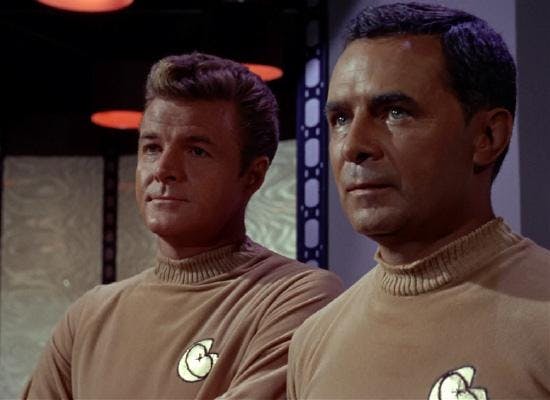
Antares' Captain Rampart, and his XO wearing the Merchant Marine Spacecraft Duty Insignia.
Not long after that, we get a look at another new insignia. The Outpost Duty Insignia is worn by Starfleet personnel assigned to outposts on the very edge of Federation space, the frontier. This emblem is characterized by a gold spikelet against a black background. Warning: Do not put yourself in a situation where this insignia goes on your uniform. Personnel wearing this badge never seem to live happily ever after.
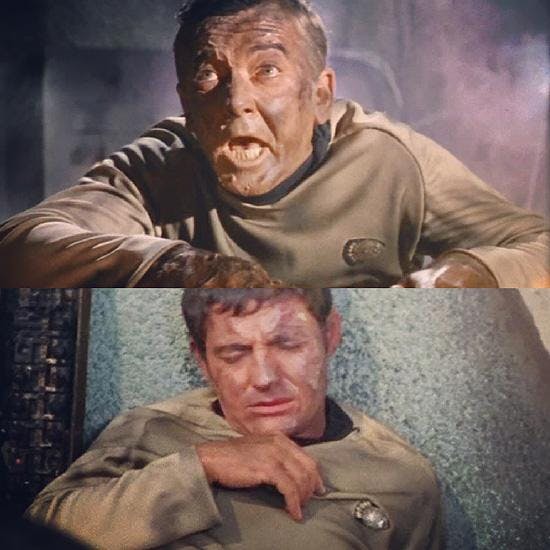
Outpost Crew from "Balance of Terror" & "Arena" pictured wearing the Outpost Duty Insignia.
A few episodes later, theEnterprisetakes shore leave and Kirk reminisces about his days at the Academy. Worn by students attending Starfleet Academy, the Cadet Duty Insignia is characterized by a pewter colored, smaller version of the Starbase Duty Insignia.
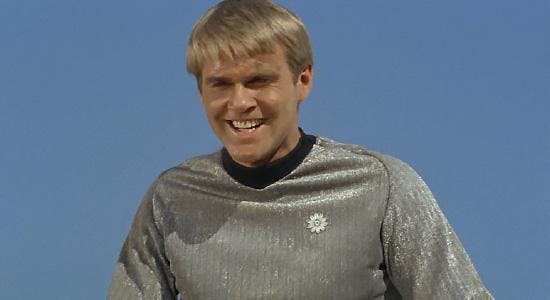
Second Class Midshipman Finnegan wearing the Cadet Duty Insignia.
First seen in "The Menagerie," the Starbase Duty Insignia is worn by personnel assigned to Federation Starbases, which include Starfleet Headquarters, space stations, drydocks, and other ground installations. The emblem, which is devoid of any departmental symbol, is a stylized representation of an “Evening Starflower” (a flowering plant native to the western hemisphere of Earth).
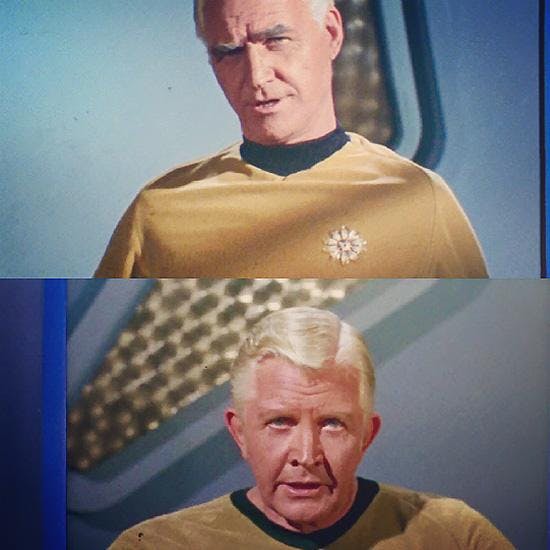
Above: Admiral James Komack of Starfleet Command - Sector 9, and Below: Admiral Fitzpatrick.
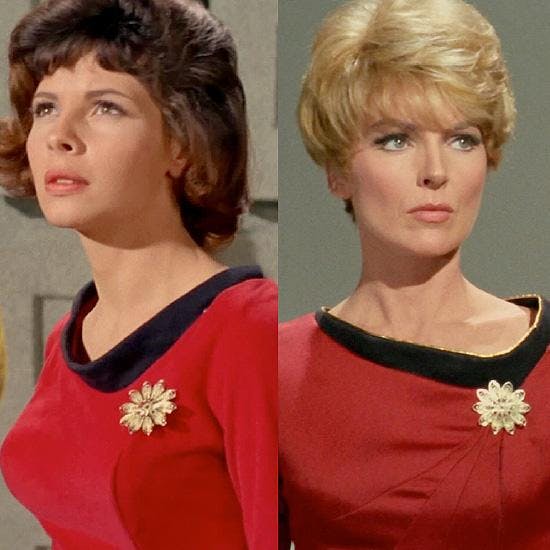
Miss Piper, assistant to Commodore Mendez, and Lt. Areel Shaw Starbase 11 JAG Officer wearing the Starbase Duty Insignia.
So how does Commodore Wesley in "The Ultimate Computer," or Commodore Decker in "The Doomsday Machine," fit into the spectrum of Starfleet insignia?
Well, let’s talk about commodores for a moment. A commodore is a flag officer rank, one position above captain. A starship captain usually commands a single vessel, but a commodore ordinarily commands more than one ship. Usually, commodores command a group of ships (either close to their flagship or distant), or in the case of TOS, they normally command a starbase.
In charge of evaluating the operational performance of the M5 computer while it's in total control of a starship, Commodore Wesley sits in temporary command of the U.S.S. Lexington to lead a battle fleet in war games against the Enterprise. Throughout the episode, Commodore Wesley continues to wear his Starbase Duty Insignia, while the Lexington crew would have been wearing the delta.
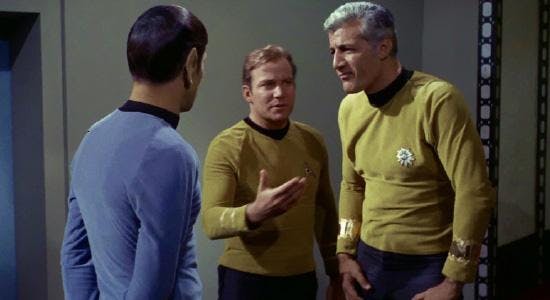
Commodore Bob Wesley in the transporter room briefing Captain Kirk and Mr. Spock about the M5 computer.
Finally, we come to one of my favorite characters ever — Commodore Matt Decker in "The Doomsday Machine." We saved him for last because we could only properly discuss his insignia and what it means after we talked about Starfleet’s other symbols first.
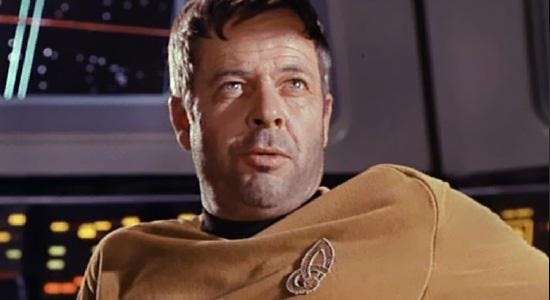
William Windom as Commodore Matt Decker
Unlike Commodore Bob Wesley, who was only in temporary command of the Lexington, Matt Decker is a Flag Officer with permanent field command of a starship. In fact, he's the only Flag Officer we see in Star Trek with a field command. As a consequence of Commodore Decker's rank and status as Commander of the U.S.S. Constellation (his flagship), he wears the Fleet Command Insignia denoting his status as a Flag Officer in the field. If we had seen Commodore Decker's crew (may they rest in peace), we would have seen the delta shape insignia in use on their uniforms. Commodore Decker's own first officer would have held the rank of Captain and worn the Starship Duty Insignia.
It should be noted that "The Doomsday Machine," which was filmed early in Season 2, is not referenced in Bob Justman’s memo. Some speculate that Decker’s absence from the memo is further indication of the inconsistent use of emblems in Star Trek, but that presupposes that the production staff missed that detail. However, the very existence of the Justman memo, and a whole forest of others just like it, demonstrates that the opposite is true.
The production team of Star Trek worked diligently to ensure that every aspect of the future they were busy creating held up under scrutiny. Gene Roddenberry was notoriously rewriting scripts himself to ensure no less than exactly what he wanted ended up on-screen, and that fastidious nature permeated the entire production staff. That Decker’s unique emblem is not mentioned in the production memo indicates that his particular insignia isn't an error at all; but represents something else.
Check out Commodore Decker's insignia. Remember that when Theiss created the insignia for Captain Ron Tracey, he went out of his way to ensure it was emblazoned with a Command Star department symbol. Commodore Decker has no such departmental symbol in his insignia patch, which places it in the same design lineage as the Starbase Duty Insignia, which is also devoid of any departmental symbol.
At this point in Star Trek, we’ve seen a number of flag officers; but they have all worn the Starflower shape, which indicates assignment to a starbase, while Matt Decker alone in TOS series serves as a flag officer in permanent command of a starship. He is wearing an insignia that conveys his unique status, the Fleet Command Insignia, and if you look closely, you'll see that Matt Decker’s emblem is visually related to the Starbase Duty Insignia. Decker’s insignia is a stylized representation of an individual petal from the same “Evening Starflower” emblem that comprises the starbase symbol. This insignia isn't mentioned in the production memo because it's not an error at all.
Hopefully, by now, you can see how consistent the Star Trek costume department really was in their use of insignia, and that Bill Thiess never repeated the error he made during "The Omega Glory" after it was pointed out by the memo.
Returning to the delta, Roddenberry and Justman intended it to be a very special symbol that communicates something important. The insignia worn on Starfleet uniforms is the equivalent of the badges worn by U.S. Service members — to show how they serve, not where they serve. Both men served with distinction in World War II. Roddenberry was an Army Air Corps pilot and Justman was a radio operator in the Navy. In the air and at sea, they understood the value of visual communication. In uniform, they themselves carried those values on their chests, on their collars, and on their sleeves. Twenty years after they wore their own various insignia, they helped to create something new — a symbol to inspire others. In the 1960s, the Starfleet delta had far more in common with the golden pin awarded to a NASA astronaut than a simple mission patch, and it was intended to equal that proud emblem in both use and sentiment.
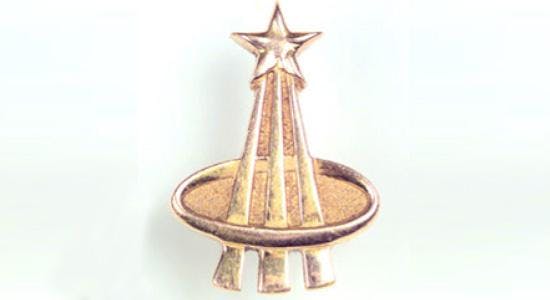
The NASA Astronaut Pin. There are two versions of this pin, a silver pin awarded to those who complete their training, and a gold pin awarded only to astronauts who have flown in space.
The delta proclaims that the person wearing it has achieved the goal of every cadet entering the Academy, and the dream of many a devoted fan — to serve aboard a starship and set sail in an endless sea of stars.
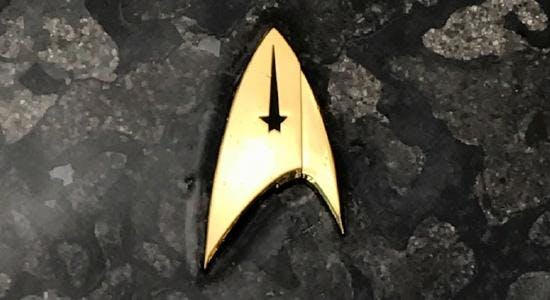
Starfleet Insignia Badge, Command Division from Star Trek Discovery
They used to say if man could fly, he'd have wings. But he did fly. He discovered he had to.
Captain James T. Kirk

I am grateful to have an experienced and learned group of expertStar Trek fans who helped with the research on this article — Steve Fronczek, Creative Services Manager, ANOVOS; Lieutenant Commander Michael J. Quigley, United States Navy; and Dayton Ward,Star Trek author.





